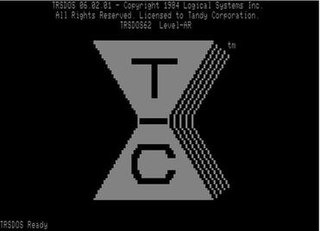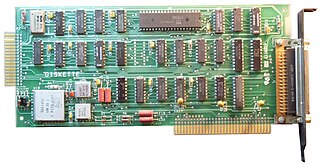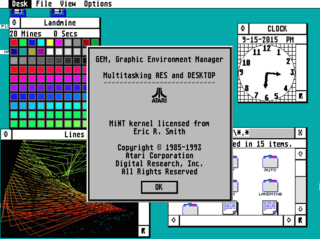Related Research Articles

A floppy disk or floppy diskette is a type of disk storage composed of a thin and flexible disk of a magnetic storage medium in a square or nearly square plastic enclosure lined with a fabric that removes dust particles from the spinning disk. The three most popular floppy disks are the 8-inch, 5¼-inch, and 3½-inch floppy disks. Floppy disks store digital data which can be read and written when the disk is inserted into a floppy disk drive (FDD) connected to or inside a computer or other device.

CP/M, originally standing for Control Program/Monitor and later Control Program for Microcomputers, is a mass-market operating system created in 1974 for Intel 8080/85-based microcomputers by Gary Kildall of Digital Research, Inc. CP/M is a disk operating system and its purpose is to organize files on a magnetic storage medium, and to load and run programs stored on a disk. Initially confined to single-tasking on 8-bit processors and no more than 64 kilobytes of memory, later versions of CP/M added multi-user variations and were migrated to 16-bit processors.
Apple DOS is the family of disk operating systems for the Apple II series of microcomputers from late 1978 through early 1983. It was superseded by ProDOS in 1983. Apple DOS has three major releases: DOS 3.1, DOS 3.2, and DOS 3.3; each one of these three releases was followed by a second, minor "bug-fix" release, but only in the case of Apple DOS 3.2 did that minor release receive its own version number, Apple DOS 3.2.1. The best-known and most-used version is Apple DOS 3.3 in the 1980 and 1983 releases. Prior to the release of Apple DOS 3.1, Apple users had to rely on audio cassette tapes for data storage and retrieval.
Disk formatting is the process of preparing a data storage device such as a hard disk drive, solid-state drive, floppy disk, memory card or USB flash drive for initial use. In some cases, the formatting operation may also create one or more new file systems. The first part of the formatting process that performs basic medium preparation is often referred to as "low-level formatting". Partitioning is the common term for the second part of the process, dividing the device into several sub-devices and, in some cases, writing information to the device allowing an operating system to be booted from it. The third part of the process, usually termed "high-level formatting" most often refers to the process of generating a new file system. In some operating systems all or parts of these three processes can be combined or repeated at different levels and the term "format" is understood to mean an operation in which a new disk medium is fully prepared to store files. Some formatting utilities allow distinguishing between a quick format, which does not erase all existing data and a long option that does erase all existing data.
In computer science, group coded recording or group code recording (GCR) refers to several distinct but related encoding methods for representing data on magnetic media. The first, used in 6250 bpi magnetic tape since 1973, is an error-correcting code combined with a run-length limited (RLL) encoding scheme, belonging into the group of modulation codes. The others are different mainframe hard disk as well as floppy disk encoding methods used in some microcomputers until the late 1980s. GCR is a modified form of a NRZI code, but necessarily with a higher transition density.

TRSDOS is the operating system for the Tandy TRS-80 line of eight-bit Zilog Z80 microcomputers that were sold through Radio Shack from 1977 through 1991. Tandy's manuals recommended that it be pronounced triss-doss. TRSDOS should not be confused with Tandy DOS, a version of MS-DOS licensed from Microsoft for Tandy's x86 line of personal computers (PCs).

Atari DOS is the disk operating system used with the Atari 8-bit computers. Operating system extensions loaded into memory were required in order for an Atari computer to manage files stored on a disk drive. These extensions to the operating system added the disk handler and other file management features.
The IBM eXtended Density Format (XDF) is a way of superformatting standard high-density 3½-inch and 5¼-inch floppy disks to larger-than-standard capacities. It is supported natively by IBM's PC DOS versions 7 and 2000 and by OS/2 Warp 3 onward, using the XDF and XDFCOPY commands.
Floppy disk format and density refer to the logical and physical layout of data stored on a floppy disk. Since their introduction, there have been many popular and rare floppy disk types, densities, and formats used in computing, leading to much confusion over their differences. In the early 2000s, most floppy disk types and formats became obsolete, leaving the 3+1⁄2-inch disk, using an IBM PC compatible format of 1440 KB, as the only remaining popular format.
Distribution Media Format (DMF) is a format for floppy disks that Microsoft used to distribute software. It allowed the disk to contain 1680 KiB of data on a 31⁄2-inch disk, instead of the standard 1440 KiB. As a side effect, utilities had to specially support the format in order to read and write the disks, which made copying of products distributed on this medium more difficult. An Apple Macintosh computer running Disk Copy 6.3.3 on the Mac OS 7.6 or later operating system can copy and make DMF disks. The first Microsoft software product that uses DMF for distribution were the "c" revisions of Office 4.x. It also was the first software product to use CAB files, then called "Diamond".
Amiga Disk File (ADF) is a file format used by Amiga computers and emulators to store images of floppy disks. It has been around almost as long as the Amiga itself, although it was not initially called by any particular name. Before it was known as ADF, it was used in commercial game production, backup and disk virtualization. ADF is a track-by-track dump of the disk data as read by the Amiga operating system, and so the "format" is really fixed-width AmigaDOS data tracks appended one after another and held in a file. This file would, typically, be formatted, like the disk, in Amiga Old File System (OFS).

A floppy-disk controller (FDC) is a hardware component that directs and controls reading from and writing to a computer's floppy disk drive (FDD). It has evolved from a discrete set of components on one or more circuit boards to a special-purpose integrated circuit or a component thereof. An FDC is responsible for reading data presented from the host computer and converting it to the drive's on-disk format using one of a number of encoding schemes, like FM encoding or MFM encoding, and reading those formats and returning it to its original binary values.
A bad sector in computing is a disk sector on a disk storage unit that is unreadable. Upon taking damage, all information stored on that sector is lost. When a bad sector is found and marked, the operating system like Windows or Linux will skip it in the future. Bad sectors are a threat to information security in the sense of data remanence.
HDCopy is a disk image application for floppy disks that runs in MS-DOS. It can copy a floppy on the fly, or by using archives with IMG file extension that store the content of the disk with a proprietary file format . For the proprietary file format compression can be used or deactivated. The compression algorithm is called "Byte-Run-2-Algorithm" by the author.

FileWare floppy disk drives and diskettes were designed by Apple Computer as a higher-performance alternative to the Disk II and Disk III floppy systems used on the Apple II and Apple III personal computers. The drive is named Apple 871 in service documentation, based on its approximate formatted storage capacity in kilobytes, but is most commonly known by their codename Twiggy, after the famously thin 1960s fashion model named Twiggy.
Superformatting is the process of formatting a floppy disk at a capacity that the disk is not designed for. It can ruin a floppy disk, but it is used in some floppy-based Linux distros to increase the room for applications and utilities. muLinux is a notable example of this technique. Another common use was to format low-density 3.5-inch or 5.25-inch floppies as high-density, or in the case of 3.5-inch disks, even extra-high density (HD-36).

TOS is the operating system of the Atari ST range of computers. This range includes the 520ST and 1040ST, their STF/M/FM and STE variants and the Mega ST/STE. Later, 32-bit machines were developed using a new version of TOS, called MultiTOS, which allowed multitasking. More recently, users have further developed TOS into FreeMiNT.
2M is a DOS program by the Spanish programmer Ciriaco García de Celis. It enables higher than normal capacity formatting of floppy disks. It saw active development from 1993 to 1995. The last version, v3.0, was released on 6 March 1995. It was written in C and assembler and compiled using Borland C++ 3.1.

The floppy disk is a data storage and transfer medium that was ubiquitous from the mid-1970s well into the 2000s. Besides the 3½-inch and 5¼-inch formats used in IBM PC compatible systems, or the 8-inch format that preceded them, many proprietary floppy disk formats were developed, either using a different disk design or special layout and encoding methods for the data held on the disk.